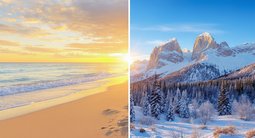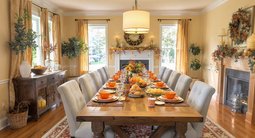TL;DR
Shopping for the best places to buy a winter home in the US starts with climate, travel time, and year-round appeal. Balance warm destinations like Anna Maria Island or Phoenix with cold-weather classics such as Jackson Hole, South Lake Tahoe, and Okemo in Vermont. Compare typical home values, rental potential, and local rules, then plan furnishings and finishes that stand up to sand or snow.
Warm escape or snowy adventure? Start with lifestyle and logistics

Smart entryway design balances function and style for effortless winter home living across climates.
If you daydream about swapping icy commutes for sunrise walks on the beach or first chair on a powder day, a winter home can turn a season into a ritual. The best places to buy a winter home in the US have three things in common: reliable weather, easy access, and plenty to do beyond the main attraction.
Here’s the thing. Warm or cold, a smart purchase goes beyond postcard views. Think drive time from a major airport, local short-term rental ordinances, and homes that hold their value. To help you compare, we’ve highlighted six standout markets people consistently love: Anna Maria Island and Beaufort for coastal calm, Phoenix for desert sunshine, Jackson Hole and South Lake Tahoe for big-mountain energy, and Okemo in Vermont for family-friendly skiing.
Designers often remind clients that a vacation property should feel effortless. Choose durable materials, clear zones for gear or beach bags, and furniture scaled to how you actually gather. Get those fundamentals right and the rest gets fun.
The short list: 6 best places to buy a winter home
These destinations balance lifestyle perks, strong amenities, and recognizable names that help with resale and rental demand.
- Anna Maria Island, Florida – A seven-mile barrier island with height restrictions that preserve low-rise charm and uninterrupted Gulf views. Typical listing prices often sit in the low multimillion range for waterfront, with smaller bungalows trending lower. Expect gentle surf, wildlife sightings, and a bike-first pace. Photo caption idea: "Winter beach house on Anna Maria Island with pastel sunset."
- Beaufort, South Carolina – A storied Lowcountry town with mild winters, historic architecture, and access to beaches and marshes. Homes frequently range from mid-300s upward in town, with higher prices in gated or waterfront communities. You’re 1 to 1.5 hours from Charleston or Savannah, which makes weekend visits practical. Photo caption idea: "Historic Beaufort cottage framed by live oaks and Spanish moss."
- Phoenix, Arizona – Sun, golf, hiking, and cultural institutions with minimal winter rain. Single-family home medians often land in the low 400s, with wide variety by suburb. Buyers favor neighborhoods within 30 to 45 minutes of Sky Harbor for convenient arrivals and quick tee times. Photo caption idea: "Desert modern home at golden hour with mountain backdrop."
- Jackson Hole, Wyoming – A bucket-list mountain market with roughly 2,500 acres of in-bounds skiing and around a 4,100-foot vertical drop. Limited developable land keeps supply tight and prices high, often several million for single-family homes. Beyond downhill, you have Nordic trails, sleigh rides, and access to national parks. Photo caption idea: "Teton view cabin after fresh snowfall."
- South Lake Tahoe, California – Lively, accessible, and comparatively more affordable than some Western ski enclaves. Many homes list in the mid to high six figures, with lake-proximate and remodeled properties commanding more. Heavenly’s terrain spans two states, and the area gets high marks for snowmaking consistency. Photo caption idea: "A-frame near Heavenly with snow-dusted pines."
- Okemo Mountain Resort, Ludlow, Vermont – Consistently rated as family friendly, with more than 600 skiable acres and robust snowmaking that covers the vast majority of the mountain. Townhomes and chalets vary widely, with many listings hovering around the low to mid six figures. It’s about 3 hours from Boston and just under 5 from New York, ideal for long weekends. Photo caption idea: "Cozy Vermont chalet with stacked-firewood wall."
Experts recommend prioritizing ease of arrival in winter: aim for a drive under 2 hours from a major airport or a non-connection flight to keep usage high.
Anecdote
On a scouting trip to Tahoe, I watched a buyer stand quietly on a porch at 7 a.m. counting cars on the road to the lift. He smiled and said, "If I can be on snow in under 15, I’ll actually use this place." He bought that week. Usage is the one metric that predicts long-term satisfaction.
Common mistakes when buying a winter home
Most winter-home regrets trace back to rushing the research or buying for a fantasy instead of real life.
- Ignoring short-term rental rules. City and HOA policies can change, and fines add up. Always verify whether nightly rentals are allowed, minimum stays, and permitting timelines in writing.
- Underestimating carrying costs. Snow removal, flood insurance, HOA dues, and utility spikes can add 15 to 25 percent to your annual budget. Get a line-item estimate before you offer.
- Buying too far from the action. In ski towns, being more than 15 minutes from the lift often reduces use. In beach markets, homes beyond a 10 to 15 minute walk lose spontaneous appeal.
- Overlooking storage and mudroom space. Gear and sand need a landing zone. Plan for 24 to 30 inches of hanging width per person and closed storage for sunscreen or wax.
- Furnishing for Instagram, not durability. In rental-friendly homes, choose performance fabrics, indoor-outdoor rugs, and wipeable finishes. Designers often advise slipcovers for sofas and machine-washable duvets.
Pro tips to choose and furnish a winter home that works year-round
A clear framework makes the decision faster and the home easier to live in from day one.
- Use the 3-2-1 rule of access. Three solid activities you love, two seasons of use, and one straightforward way to get there. If all three check out, the market deserves a closer look.
- Budget with a cushion. Add 10 percent to your annual maintenance budget the first year for unknowns. In snow country, plan for roof loads and de-icing. In coastal zones, budget for salt-air wear and exterior paint every 5 to 7 years.
- Think orientation. South- or west-facing patios in desert markets extend winter evenings. In mountain homes, morning light on the breakfast nook helps with early starts and mood.
- Design for function first. Create an entry with a bench, hooks at 66 inches, and a washable runner. In beach homes, include an outdoor shower and a ventilated closet for damp towels.
- Choose rental-smart finishes. Performance upholstery, non-porous counters like quartz, and LVP or sealed wood floors handle sand and slush better than sisal or marble.
- Stage with intent. A king bed in the primary, two twins or a bunk room for kids, and a pull-out in the flex space maximize occupancy. Good photos follow good space planning.
- Prototype the look. Use visual design tools to test layouts and palettes before buying furniture. Platforms like ReimagineHome can mock up coastal, desert, or alpine schemes against your actual floor plan.
Designers often advise keeping palettes calm and textural in second homes so the landscape does the talking.
Real stories from winter-home buyers
Real-world choices reveal what the spreadsheets miss.
- The snow-chasers who went smaller. A couple traded a sprawling cabin an hour from the lift for a compact condo 8 minutes from the gondola. They skied 3 times more often and cut heating costs by 30 percent.
- The beach family that mastered storage. After two sandy seasons, they added a lockable owner’s closet, outdoor shower, and labeled bins for towels and toys. Turnovers got faster, and damage claims dropped.
- The desert host who fixed arrival. Guests kept arriving late, hungry, and cranky. Moving to a neighborhood 20 minutes closer to the airport boosted five-star reviews because check-in felt effortless.
- The multigenerational crew that designed zones. They split a large great room into three: a conversation area, a kids’ game rug, and a window-facing reading corner. Suddenly, everyone could unwind at once.
Visualization Scenario
Imagine a January evening in your winter home: gloves drying on a peg rail, a washable runner catching drips, and a low sofa that faces the view. The dining pendant dims to a warm 2700K, and a stack of extra blankets lives in a lidded basket by the fire. The room breathes because the furniture fits how you gather. Tomorrow, skis or sandals, you’re out the door in minutes.
FAQ: buying a winter vacation home
- What are the best places to buy a winter home in the US?
Top picks include Anna Maria Island FL, Beaufort SC, Phoenix AZ, Jackson Hole WY, South Lake Tahoe CA, and Okemo VT. These offer strong amenities, recognizable names, and dependable winter weather. - Should I buy a winter home in a warm or cold climate?
Choose based on how you spend most winter days. Warm markets maximize daily use with low maintenance, while ski towns offer lifestyle prestige and rental demand but higher carrying costs. - How much should I budget for a winter vacation home?
Beyond mortgage and taxes, plan 15 to 25 percent annually for maintenance, utilities, snow removal or landscaping, insurance, and HOA dues. Add a 10 percent contingency in year one. - What is the best time to buy a winter home?
In ski towns, late spring can reveal roof and drainage issues and may offer more negotiating room. In beach markets, late summer and early fall often bring motivated sellers after peak season. - How do I maximize rental income from a winter home?
Buy within 10 to 15 minutes of the beach or lift, furnish with durable performance materials, and invest in professional photography and a clear house manual. Verify short-term rental rules before closing.
Bottom line: buy for how you live, then design for how you host
Winter homes work best when they serve your real routines. Pick a market that matches how you move, keep travel simple, and design for sandy flip-flops or dripping ski boots without stress. If you plan to rent, let durability lead and document everything from house rules to how the fireplace works.
Ready to picture the space before you sign a single furniture order? Experiment with palettes, furniture placement, and room-by-room layouts using ReimagineHome so your winter home looks as good as it lives.
.svg)

.svg)














.png)